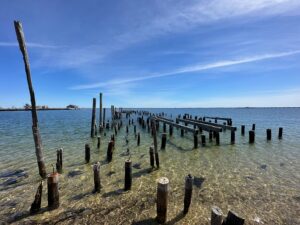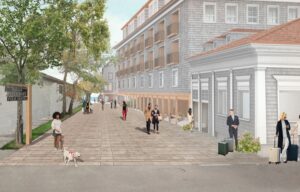PROVINCETOWN — Christine Barker’s proposed pier and floating marina, recently redesigned and enlarged to extend 1,270 feet into Provincetown Harbor from the site of the derelict Old Reliable Fish House, is drawing pushback from state agencies, the town conservation commission, and neighboring business owners.

The pier and marina are components of Barker’s ambitious proposal for a complex featuring two hotels with a total of 50 rooms, 13 condominiums, two restaurants, and some retail space, spanning 227, 227R, and 229 Commercial St.
Construction, broken into five phases, is expected to begin this fall and conclude in the spring of 2027, based on documents Barker’s organization, Ecotekture Development and Design, has filed with the state Executive Office of Energy and Environmental Affairs.
Barker has already secured approvals from Provincetown’s planning and zoning boards and historic district commission. To go forward, however, she will need permits related to construction of the pier and the effects on wetlands and buffer zones caused by the project, which is situated in the coastal flood zone.
Instead of simply replacing the original 264-foot pier, whose remains frequently serve as a backdrop to harbor sunset photos, Barker proposes a 50-foot-wide public pier extending 700 feet into the water and ending in a 570-foot floating marina with 29 boat slips. The plan would require 414 pilings for the dock and another 33 to secure the marina floats.
While Barker was hoping for a quick review under the Mass. Environmental Policy Act, the state has notified her that, based on requests from various agencies for more detailed project information, she will be required to file a full draft environmental impact report.
Among those agencies is the Mass. Office of Coastal Zone Management. The components of Barker’s project that border the harbor are in FEMA’s “velocity zone” — a term that refers to its susceptibility to storm waves — at highest risk for flooding. The landward portion of the project is in FEMA’s “AE” zone, that is, an area at risk of 100-year flooding.
The project would sit on a coastal dune, wrote Tyler Soleau, the coastal zone office’s acting director. “Since the coastal dune is in the floodplain, it has storm damage and flood control functions,” he wrote. “The EIR [environmental impact report] should address how each of the project components will meet the performance standards for coastal dunes.”
Soleau also wrote that louvered wood screening that Barker plans to install below the elevated buildings will interfere with the dune’s ability to provide storm damage protection and flood control and would likely be damaged in the velocity zone, “resulting in more storm debris and potential impacts to other buildings and infrastructure.”
Margaret Sullivan, a senior attorney with the Conservation Law Foundation, also submitted comments to state officials about the risks of building in the flood zone. “Building habitable uses like hotels and condominiums in an area with this high risk is not advisable,” Sullivan wrote.

Due to its scope, Barker’s plan must undergo review by the Cape Cod Commission as a development of regional impact. Executive Director Kristy Senatori wrote to the state saying the commission would benefit from a more detailed analysis of project impacts expected to come with the state’s full environmental review.
The commission’s letter raised concern over wildlife and plant habitat and wetland resources. “As proposed, the project results in significant increases in gross floor area, impervious footprint, and intensity of use for non-water dependent uses and structures,” the letter said. “Staff strongly encourages the consideration of alternatives that minimize development impacts, especially in the [velocity] zone.”
Barker has begun the local permitting process with the conservation commission, which spent considerable time at its March 19 meeting discussing issues raised by the state Div. of Marine Fisheries and by its own members.
“The installation of hundreds of piles will displace shellfish habitat,” wrote DMF environmental analyst Amanda Davis. The area is also in the spawning habitat of winter flounder. “Given the unknown status of the Gulf of Maine winter flounder stock, every effort should be made to protect the species and its spawning habitat,” Davis wrote.
A meadow of eelgrass now grows in the footprint of the proposed pier, extending from the old pilings 400 feet seaward, according to Davis. Installation of the new pilings and the shading caused by an expanded pier and floating docks will affect the growth of the eelgrass.
While Barker has proposed some mitigation planting, Davis suggested more because eelgrass has a success rate of only about 30 percent.
Marshall Puffer, Barker’s engineer from Tighe & Bond, responded to the state’s comment on shellfish habitat by saying that shellfish harvesting is prohibited at the site because of contamination. But Conservation Agent Melyssa Millett said that her commission’s charge is to protect habitat for shellfish as a whole whether or not the area is being harvested.
Millett added that the commission would require more specific information on how the eelgrass, planted to replace the bed being disrupted, would be maintained over time.
Conservation commission chair Alfred Famiglietti brought up the 50-foot buffer zone, a waterfront resource area where new buildings have not been allowed. Currently, the Old Reliable sits within the buffer zone on a coastal dune. The new construction will also extend into the buffer. “I’ve been on this commission for nine years,” Famiglietti said. “We’ve never allowed buildings in the 50-foot buffer.”
Vice chair Nathaniel Mayo agreed: “Why allow this if we wouldn’t allow a cottage built there?” he asked.
The owner of the Provincetown Marina at Fisherman’s Wharf said Barker’s expansion would extend through the middle of the mooring field and disrupt the existing marina’s operation. The recently rebuilt marina offers 100 slips and 100 moorings. In a letter to the commission, Ann LaGasse, a principal of Provincetown Marina LLC, said $15 million in improvements have been done there, including new dockage, moorings, a marina office, employee housing, fuel dock, and installation of a 725-foot wave attenuator to reduce wave heights and protect the marina.
An attorney for abutter Patrick Patrick, owner of Marine Specialties, brought up the ongoing dispute between Barker and Patrick over their property line. In a pending Land Court case, Patrick and Barker rely on two conflicting surveys.
“Our position is, they can’t construct the project because it’s on land they don’t own,” said Patrick’s attorney, Alan Lipkind.
Patrick, who has been fighting the project in court since 2020, also addressed the conservation commission. “This project has been a steamroller and a runaway train at every turn,” he said. The commission plans to discuss Barker’s proposed development further at a continued hearing on April 16.
Barker told the Independent, “We are carefully reviewing the commission’s comments and concerns and are considering solutions to address them.”



